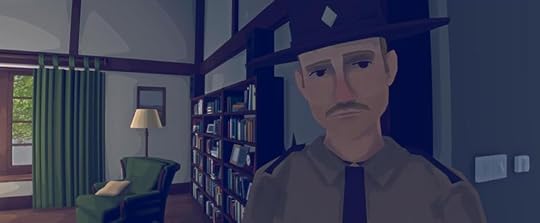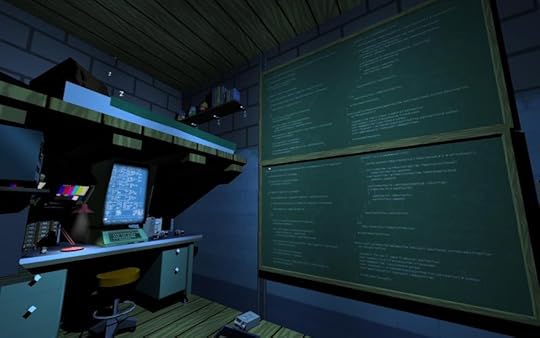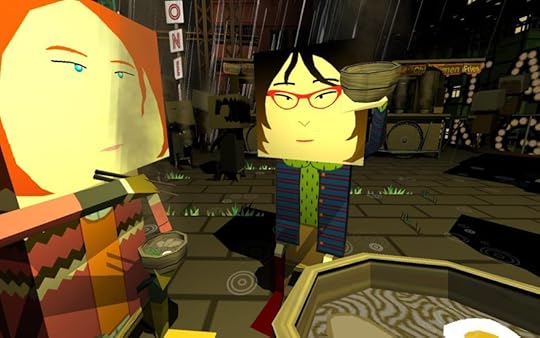Kill Screen Magazine's Blog, page 84
July 27, 2016
Eerie adventure The Edgelands knows the power of sound design
Though often marginalized in favor of flashier words like “graphics” and “gameplay” and “fully-immersive-like-for-real-this-time,” sound design can be one of the most gripping parts of a game. Just ask anyone whose hackles are automatically raised at battle music from an RPG, or who’s spent sleepless nights ducking away from incorporeal whispers in a horror game.
One of my all-time favorite moments in videogames was at the end of Kentucky Route Zero’s (2013) interlude The Entertainment, where the low buzz of electric lights is your one warning before the Hard Times boys come to collect. We often think of video games as a tactile medium with visible support, but you can’t denounce the charm of walking through grass that rustles as you touch it, or the satisfaction of the metal slide of a sword unsheathing. Of course, there are games at the other end of the spectrum that draw their gameplay and motivation from music: Panoramical (2015) comes to mind, as well as the well-worn classic Rez (2001).
“Are there goblins in the woodshed?”
Somewhere between games that contain music—so, every game that has a soundtrack—and Music Games™ is The Edgelands, an atmospheric adventure game funded by Failbetter Game’s Fundbetter project. One of the first five games to come out of the program, The Edgelands is, as put by developer Andre Bosman, an “Uncanny Rustic Adventure.” At its simplest it’s a game about myth, about exploring the in-between spaces that may or may not contain something we don’t quite understand. Bosman uses the allegory of a woodshed full creatures: “Are there goblins in the woodshed, or is it just weasels? Why are the weasels looking at me like that? Perhaps they are goblins after all.” He aims to create an air of uncertainty—aided, in no small part, by what he calls the game’s “soundscape.”
Bosman is a musician under the name Hoofus, and has been working with the eerie for years. His music is a chilling but compelling experiment with industrial sounds, strange enough to make you sit up straighter, and sounds just like the “dream-like blurring of the ordinary and supernatural” that he’s advertising in The Edgelands.
In his first devlog, he elaborated on how ambient interactions will add to the atmosphere already created by the music, with the opportunity to interact with your environment in simple ways—startling a bird or a squirrel, looking under rocks—accompanied by quiet sound effects designed to blend in with the vibe of the game, not distract from it. What is left is the mood created by this combination, and how it escorts you as you poke around the unreal world, an audial reminder that the seam between myth and truth is not quite strong enough to be seen.
The Edgelands is set for release in early 2017: check out its Steam Greenlight campaign.
The post Eerie adventure The Edgelands knows the power of sound design appeared first on Kill Screen.
Sacramento is way too darn pretty
Sacramento is a fleeting memory, a transitory moment for one to enjoy before life resumes its course. Creator Delphine Fourneau—who also goes by the name Dziff—describes the game as ephemeral; it’s the best word I could find to describe it, too.
The scenes in Sacramento are snippets of Fourneau’s own memories of a train journey taken across the United States. She didn’t intend the memories to be literal, however—that’s not what Sacramento is about. Rather, it’s about the “impressions of these ephemeral places that leave you these sweet pictures in the back of your mind,” she said.
In Sacramento, players simply wander—or “drift aimlessly”—through Fourneau’s surreal and dreamlike landscape. Music and sound design from Glass Body helps create the “comfy and calm” atmosphere Fourneau looked to embrace. Nothing is sudden. Despite memories fading in and out as players explore Sacramento, there is no rush to see everything. There’s an emphasis on being present—staying in the moment—while one is able to. A player’s time in Sacramento is not infinite; one moment will not last forever. However, that moment will be around to visit at another time. Eventually, Sacramento will fade back to its opening screen. Ephemeral.
impressions of these ephemeral places that leave you these sweet pictures in the back of your mind
Sacramento has its own meaning for Fourneau, but it’s not a story she exactly wanted players to share. “I rather wanted the player to project [their] own story and memories,” she said. She wants players to impress their own memories of travel on the canvas she’s provided.
Sacramento was released yesterday on itch.io. It’s available on PC and Mac.
The post Sacramento is way too darn pretty appeared first on Kill Screen.
The new generation of arcades
This article is part of a collaboration with iQ by Intel .
Nostalgic arcade games offer larger-than-life experiences on big-screen TVs, encouraging new generations of gamers to come together and play. The clang of quarters dropping into Frogger (1981) or Tetris (1984) cabinets is a fleeing memory for many, but the joy of playing original arcade games like Pac-Man (1980), Donkey Kong (1981) and Space Invaders (1978) is far from dead. Instead, the combination of creative independent developers and technologies that easily bring these indie games to big-screen TVs is sparking an arcade game renaissance that’s spreading across living rooms and festivals around the world.
“A lot of people don’t know about indie games and the alternative scene,” said Thorsten Wiedemann, co-founder and artistic director of A MAZE Berlin. The yearly festival combines boisterous bar scenes with arthouse indie games, which are created by creative individuals or small teams often with very little budget. These gatherings often blend new games and technologies with a retro atmosphere that harkens back several decades when young people flocked to public arcade halls to play early digital videogames like Joust (1982) and Centipede (1980). This year, A MAZE Berlin took place over two days and nights in Friedrichshain, a district famous for its outdoor beer gardens, street artists and club scene. More than 1,200 young people flocked to the party celebrating a diverse and creative set of games.
A Maze Berlin 2016 by Jens Keiner
Unlike old arcade halls, games came to life on large TV and projection screens, illuminating throngs of street artists, painters, actors and musicians. At the event, Wiedemann used a variety of computers connected to 40-inch screens to build his exhibit. “I like to make the games bigger to turn it into that ‘wow!’ experience. You get excited when you walk through that door.” Wiedemann is part of a posse reinvigorating arcade culture. It’s something people enjoy sharing in public but also intimate places, like at home, where devices like the portable Intel Compute Stick can turn any HDMI-equipped TV into an arcade extravaganza. Off-the-wall game experiments also reign supreme in other parts of the world. Wiedmann’s friends at the gaming collective Babycastles regularly throw extravagant events in Manhattan. A couple of years ago, they projected Ms. Pac-Man across all four walls (and even the ceiling) of a room in the Museum of Modern Art.
Similarly, the London-based party organizers The Wild Rumpus bill themselves as “part arcade, part night club,” blending videogames with EDM-thumping raves. Ushering arcades into the millennial era, creativity and accessibility define this new kind of social gaming. But the true attraction of those old cabinet arcade days remains: to come together and play. From living rooms to bars, indie designers contribute to new arcade culture by creating mesmerizing visuals and alluring experiences that anyone can enjoy almost anywhere. Increasingly these indie developers are taking advantage of the increasingly simple and portable computer technology to bring back arcade experiences. Pocket-sized “mini-computers” like Intel’s second generation Compute Stick stream lightweight indie titles to big TV screens with an HDMI port. Gamers can now play arcade games once limited to old, bulky cabinets on large, high-definition screens at home, a friend’s house or a public gathering.
creativity and accessibility define this new kind of social gaming
According to the novelist Michael Kimball, who published the memoir Galaga with Boss Fight Books in 2014, arcades help establish a community and culture around gaming. “I grew up in a time in America when most people didn’t have access to videogames and then all of a sudden nearly everybody had access if they had a quarter,” Kimball said, remembering the birth of arcades in the late 1970s and early ‘80s. In the mid-2000s, independent game designers began carrying their wares to trade shows and galleries, and impromptu arcades began to spread. Traveling with a heavy cabinet game wasn’t easy. It often required a truck and a team of technicians to move and configure it. Aside from big screen TVs, new portable technologies removes much of the heavy lifting once required to set up an arcade.
Games like Circa Infinity (2015), originally developed for PCs and mobile phones, thrive on the big screen thanks to mind-melting aesthetics and mechanics. A deceptively simple game about navigating through endless circles, this interactable optical illusion captivates players and spectators alike. “Even if you don’t know what’s going on, the game is fun to watch,” said Kenny Sun, the one-man team behind Circa Infinity, explaining why its design attracts voyeurs as much as players. “It’s fun to figure out what’s going on since there’s so much visual stimulus.” Portability also allows Sun to easily take his game to festivals in Seattle, Portland, San Francisco and Austin.
A Maze Berlin 2016 by Jens Keiner
Mark Essen, one of the creators behind the classic couch co-operative game Nidhogg (2014), also saw the new arcade—from public events to house parties—as an opportunity while designing his most recent title, Flywrench (2015). “I wanted Flywrench to be the kind of approachable game that someone could watch you play and understand what you’re experiencing,” he said. As a result, the game builds on accessible mechanics similar to that of Flappy Bird (2013) or the freeware classic Helicopter Game (2004). “It’s very streamlined,” he said. “There’s no inventory. Nothing going on outside of what you see on the screen.” With the list of lightweight indie games growing by the day and designers gravitating toward more accessible and social experiences, the arcade of today appears to be more than just a resurrection. It’s a gaming metamorphosis.
Feature photo credit: Jens Keiner
The post The new generation of arcades appeared first on Kill Screen.
Virginia learns from film to tell its interactive drama later this year
Dialogue is a major aspect of storytelling across every medium, but often a lack of dialogue can be as telling as spoken words. A glare or pained look can inform you of a character’s emotions and thoughts; entering a quiet room can build tension. Games like The Walking Dead (2012) and this year’s Oxenfree often give you the option to say nothing, to stay quiet, and the upcoming “interactive drama” Virginia features no dialogue at all.
“To play it, you don’t feel like you’re in this strange world, like you walked into a library and everyone’s being incredibly hushed. It’s just the way it is,” explains developer Jonathan Burroughs in a recent interview with The Verge. Virginia drops you into scenes where dialogue is about to start or is already finished, shifting the focus to the onset and aftermaths of moments. In a game inspired by the works of David Lynch and The X-Files, this offset could foster a uniquely unsettling tone, where you’re always in a voyeuristic position relying on context to piece together the game’s mystery.
Inspired by the works of David Lynch and The X-Files
Since its reveal in 2014, Virginia has gained a more detailed aesthetic, featuring deeper hues, more expressive faces, and stylistic atmosphere, but the story remains the same. Set in the rural town of the North-East, an FBI agent searches for a missing boy, encountering dark secrets and hidden motives. Unlike other narrative-focused games, Virginia won’t unfold linearly, but rather use cinematic techniques such as cuts and edits to tell its story.
Burroughs states Thirty Flights of Loving (2012) as a major influence on Virginia‘s structure. “Games and film have been running in parallel for so long, and films have this established way to use the edit in order to contract time, to contract space, and to be able to use montage techniques to relate scenes to one another,” he explains while discussing the aforementioned game’s style. “But games, outside of cutscenes, outside of non-interactive moments, had really not embraced it at all.”
The montage of switchblades, dead birds in refrigerators, shocked looks, and furtive glances seen in recent GIFs (below) hint at a dark story and enigmatic atmosphere, hopefully enhanced by Virginia‘s dialogue-free narrative and cinematic format.
Virginia is expected to release this year on PC, PS4, and Xbox One. Visit the game’s site here for more details.
[image error]

The post Virginia learns from film to tell its interactive drama later this year appeared first on Kill Screen.
Hungary is more than just a pit stop in Jalopy’s long-winding roadtrip
The borders are open; those traveling Jalopy’s Eastern Bloc during its Steam Early Access phase can now roll their Laika 601 into early ’90s Hungary. That brings Jalopy’s country count up to three—Germany, Czech and Slovak Federal Republic (now Czechoslovakia), and Hungary.
With Hungary, developer Greg Pryjmachuk added subtle environmental cues to each territory in efforts to differentiate the three areas. He included things like country-branded goods—coffee in one region will look different from another, and cigarettes and sausages are now separately branded for each country. Likewise, gas stations will also “change visually” depending on the player’s location.
The country held its first parliamentary elections since communists took power in 1945
Hungary wasn’t added to Jalopy just as a change of scenery—or simply because it’s on the route to Jalopy’s eventual destination. It’s actually an important part of Jalopy’s underlying theme. During the ongoing collapse of the Eastern Bloc, Hungary rose “from the ruins left by an oppressive and corrupted political system,” Pryjmachuk told us. In the early ’90s, the country held its first parliamentary elections since communists took power in 1945; “the elections saw the Hungarian Democratic Forum destroy all other opposition, democratically.”
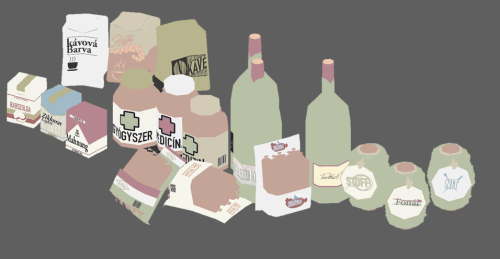
It was Hungary, in that way, that “lead the way towards a more stable, democratic and prosperous market economy” for the Eastern Bloc territories. Hungary’s political story is an “important core theme” for Jalopy. Pryjmachuk hasn’t delved too deep into Jalopy’s narrative, but he intends to: “Moving from state control into a brave market economy, giving the freedoms of industry and trade back to private organizations, and allowing people to define their own path in life is the narrative I’m looking to eventually explore,” he said.
But first, Pryjmachuk wants to fill the game with stuff—stuff that he calls to the community for help with. The developer, who works alone, keeps a detailed developer diary where he answers questions and takes suggestions from the community. It’s something that’s really important for him, “especially now the game is being sold and is an early access product.” Jalopy players have paid money to play an in-development game; for Pryjmachuk, those players deserve to be heard.
And those players wanted to customize their rides. So while the Laika 601 may still run like a jalopy, it won’t have to look like one. Jalopy’s Hungary update adds spray paint cans to the game, for the purpose of customizing the color of a player’s car. They’re purchasable from Laika dealerships—though they’re only allowed to stock a certain number of them at a time. Players will have to visit often to find the colors they want, or mix colors to make their own variant. Metallic spray paint and decals are also available, if players are interested in a Laika 601 straight out of Pimp My Ride (2004).
Players have also been begging for an odometer to track the progress made on their trips, so Pryjmachuk added that, too. “I try to take myself out of it as much as possible and listen to what people actually want,” he said. “There’s a risk of being too close to something, and letting your ego blind your judgement.” Pryjmachuk didn’t want the development process to be as it was during his time at bigger videogame studios, where the position of a designer felt more like a dictatorship role: “Do this, because I said so.”
Sometimes, though, community input in videogame design can pose a “camel” problem. (“A camel is a horse designed by committee,” Pryjmachuk added.) As demonstrated on the Jalopy developer blog, players are clamoring for backseat access in their cars—something Pryjmachuk has been hesitant to add to the game.
Still, he’s open to hearing all player suggestions, though don’t expect him to let players into the backseat anytime soon. “When the people paying you to make the horse want a hump, you’d probably be best advised to at least hear their reasoning.”
Jalopy is an Early Access game available on Steam for $12.99.
The post Hungary is more than just a pit stop in Jalopy’s long-winding roadtrip appeared first on Kill Screen.
Everything we know about The Chinese Room’s next game so far
There’s a terrible pun here about The Chinese Room leaving us totally in the dark about their new game, Total Dark, but I’m trying to be better than that. Maybe. Anyway…
It’s been a few months now since Everybody’s Gone to Rapture (2015) emerged, triumphant, on the PlayStation 4, and so it’s fair to ask what’s next for the Brighton-based studio. The answer three months ago was the self-funded RPG Total Dark, an isometric adventure game that “took inspiration from those old paper-based RPG systems of the late 80s and early 90s.”
However, in a blog post on the studio’s site yesterday, The Chinese Room has come clean about the current state of the game, admitting that pretty much everything has changed except its title, which is still Total Dark. Although, studio head Dan Pinchbeck admits that that, too, is “probably” going to be changed.
“there’s a pocket universe nineteen inches across…”
So, what are we dealing with now? Firstly, development has slowed down. Total Dark is a lot more involved than the team’s previous titles, which means that it needs more iterative testing to come together. The team now plan to have something releasable in 18 to 24 months, although have pointed out that they’d rather no one held them to that.
Secondly, they’ve got a “stripped-back 3rd person RPG-lite system that operates around five core stats.” This is coupled with “core gameplay loops” that revolve around exploring areas to complete missions and obtaining sweet loot or chatting to NPCs. Pinchbeck describes their progress so far as an “adaptable and essentially fun set of tools” that the studio will use to put together the rest of the game.
Pinchbeck also promises a “special sauce” that makes the title a little different from everything else out there, although it’s being held back for now until they’ve got more to show.
Still, what the studio is willing to share at the moment is more than enough to get me excited, despite Pinchbeck relentlessly pointing out that everything involved can change (and has, already). This piece of the blog post has me nearly chomping at the bit, however, is these hints as to the game’s story:
“In 2016, in a basement of the local history department at Bangor University, there’s a pocket universe nineteen inches across…
In 1941, SIS agent Anna Dornstein leaps from a plane above North Wales in search of bier roads, and vanishes…
In 1887, on a dark February night, all the clocks in Holyhead begin to strike thirteen…”
There’s something deeply unsettling about the three sentences, and combined with the unease at the heart of Everybody’s Gone To The Rapture, those bullet points alone are enough to keep this on my radar. This is also totally out of The Chinese Room’s wheelhouse, totally different to anything they’ve released so far, which makes me wonder what shape the final game might take.
The Chinese Room plan to release more information on Total Dark, or whatever they’ll call it next time it surfaces, in the next few months.
The post Everything we know about The Chinese Room’s next game so far appeared first on Kill Screen.
Don’t let Quadrilateral Cowboy slip through your fingers
When Brendon Chung described Quadrilateral Cowboy to IGN in 2013, he framed it as a departure from his narrative-focused work in Thirty Flights of Loving (2012) and Gravity Bone (2008). “I wanted to go in a very different direction,” he said, “and let the player experiment in a sandbox and figure out their own solutions to problems.” This third game about the seedy underbelly of Nuevos Aires—the fictional city that many of Chung’s games are set in—is much longer and more complex than its predecessors, but shares many of the same ideas about how to string quotidian moments into a larger story.
Like Portal (2007), Quadrilateral Cowboy oh-so-slowly eases you into a stack of tools, giving you a vocabulary with which to solve its puzzles. With a chunky laptop, a couple robots, and some clever programs, the main character Poncho hacks open doors in order to photograph secret documents or steal diplomatic pouches. In truth, though, you’re not on top of the cable car depicted on the screen, you’re tucked between shelves of whirring beige computer equipment, lit in fluorescent chiaroscuro. Your simulator sits in front of you, your eyes are crammed up against its headpiece as the analog machinery around you buzzes, and (judging by the misting fan) heats up the room.
Chung’s world-building is an exercise in metonymy
While you’re on VR heist-planning duty, your teammates Maisy and Lou are repairing machinery and doing chin-ups, respectively. Between heists, the cast of Quadrilateral Cowboy chills out. Less the hardened criminal degenerates of Neuromancer (1984), your crew of criminals are an everyday bunch of freelancers, taking weird gigs to get by once the regular repair and engineering work dries up. In “Carpool” levels, you pick each other up when it’s still dark out, and if you’re quick you can peek past Lou as she exits her home to see where she keeps her drawing tools and her crates of instant ramen. Through exploring the spaces you share with these characters, you come to some understanding of what their lives must be like, but also the realization that you’re never going to get to know everything—you won’t even meet the individual seen in Maisy’s bed (credited in the accompanying artbook only as “Sleepy”) as she slips out to hop on your hoverbike.
This is a technique that Chung has used and revisited before. In Thirty Flights of Loving, he zeroed in on a relationship shown in a handful of moments. It jump-cut from heist to wedding reception and back to establish that the action and the downtime rely on each other: both shootouts and quiet moments build and test the connections between its characters. And so, like its predecessor, Quadrilateral Cowboy isn’t focused on one at the expense of the other, despite its longer form and more complex action. Gravity Bone included, these games are about small stories, and presenting enough of the right fragments to convey a close relationship between friends, or a betrayal, or regret.
Similarly, everything about the locations of Nuevos Aires provokes the feeling that it’s bigger than what you can see of it. Its blockades, time restraints, and unseen actors provoke questions: Who owns the villa you’re infiltrating? Who are the sleeping bodies in the Repulse Bay Clinic, and why are they in an apparently robot-run hospital in space? Is the brain in a vat any good at trading stocks? Chung’s world-building is an exercise in metonymy—you are encouraged to wonder at the gap between the simulated space and the real version of it, left completely untouched. Chung doesn’t use overt environmental storytelling in the form of weirdly explicit graffiti, instead he packs every inch of Quadrilateral Cowboy with books, food products, notes, and personal effects. The result is a world that feels fantastical, but relatable, with idiosyncratic characters who are defined by their own preferences and actions rather than only through their interactions with you.
While there are a number of signature Chung moves throughout Quadrilateral Cowboy there are also subversions of them that show a maturity beyond his previous efforts. With Gravity Bone, for example, Chung seemed interested in critiquing typical game form: its mission structure and scoring suggest it’s going to be a long and exciting game about espionage action, but its ending puts the lie to that. When its master spy protagonist is suddenly shot and killed, it’s anti-climactic and disempowering. The expectation that the extraordinary main character will succeed against all odds is betrayed, and as he dies, his life flashes before his eyes. It’s a short experience that uses its implication of a larger game to also imply a larger life, of which you saw only a slice.
a game about reflecting on life
Now, some years later, Chung has moved on. No longer is he critiquing traditional game structures, he’s finding narrative solutions to them. This is seen in Quadrilateral Cowboy’s virtual heist preparation, which avoids obvious satire to instead invent a reason for repetition and mastery to exist within its narrative. Take the very last mission, which took me about 15 minutes to beat on my first run through. I set off a couple of unnecessary alarms at first, but eventually I got in and out. I played through it again and again, glancing at the stopwatch that stares at you from the bottom of the screen, eventually pulling off the heist in just under 2:30. Through this repetition, Poncho learns how to tackle a problem in her sleep, in under a minute. I’m blinking my mechanical eyes to deactivate the laser mesh in front of me and downloading brains at a breakneck pace, but only because I’ve screwed up many times before. The code you input is stored in your deck for the next run through, so you can scroll back up through what you’ve written, or connect every line to a blink command, and run through levels without using your deck at all.
This is how, through its heists, Quadrilateral Cowboy becomes a fantasy about mastery. Its three main characters are able to scrape by not because of their augmentations or inherent ability, but because they are prepared and meticulous. Pursuing this fantasy is also why its computer systems are simplified, made accessible. In that sense, the game’s vision of hacking isn’t any more accurate than Hollywood’s—where a couple keystrokes gets you into the Pentagon—but even when Chung abstracts the act of hacking, your interactions with the world are grounded in the step-by-step logic of programming. A hacking game where you can mistype a string of commands and spend a minute hunting for your typo is a rarity. But when it does show up, it means that, through repetition, you can improve your own play as you come to fully understand the scripting and the layout of the level you’re rushing through. Unlike Gravity Bone, it’s not about the thrill of the job gone wrong, it’s about the thrill of getting it right. Even in that last level, you don’t quite have to use all the tools at your disposal—the game spends so much time teaching you how to use your cute robots and your scripts that just as I started to feel like an unstoppable infiltrator, it was over.
With Quadrilateral Cowboy, Chung eschews the filmic jump-cuts he experimented with in Thirty Flights of Loving. Still, the fragmented plot produces a similar result: as it happens, it already feels like a collection of memories. The jobs and vignettes are this gang’s “Greatest Hits” strung together in a way that gives you an image of what they did as work for 15 years, but also their proudest and fondest moments. In some sense, it’s a game about reflecting on life, as Chung’s narratives often are. As such, Poncho appears to escape a violent end to go on and live a long life, but it’s clear the Good Old Days don’t last—days of sharing noodles and stealing your boat back from the impound lot give way. Like the hacking missions, you can replay these nostalgic moments as many times as you want, but you’ll acquire no increase in power over them. Throughout the game, you learn to manipulate environments and the analog systems that drive them, but relationships are out of your reach, withering beyond your control.
In the last minutes of the game, as in the opening, you approach a train on your hoverbike, Clair de Lune playing once again on your portable record player. Now the train’s not the target, but Poncho’s—and only Poncho’s—living space, covered in books, old gear, and scrapbook photographs of the team. Back in the hideout, Maisy reads books with titles like Violent Passions, but in the train car, under a dusty box, there are books with titles like Legal & Financial Guide to Family Caregivers. At the end of the game, when you’re sorting through this gallery of tools and photos, you’re not a safe-cracking net-hacking superhuman any more, you’re just a regular person that time caught up with.
For more about Kill Screen’s ratings system and review policy, click here.
The post Don’t let Quadrilateral Cowboy slip through your fingers appeared first on Kill Screen.
July 26, 2016
Brendon Chung and his love for big dumb plastic switches
This article is part of Issue 8.5, a digital zine available to Kill Screen’s print subscribers. Read more about it here and get a copy yourself by subscribing to our soon-to-be-relaunched print magazine.
///
The midpoint of Daft Punk’s 2013 album Random Access Memories is marked by an effusive, sprawling ode to touch. An unidentified narrator walks the listener through memories and speculation on feeling as they try to recall what seems like fading indicators of what feeling ever was. On “Touch,” we get a sense that the narrator was once organic like us. But now, metallic and glistening under a desert sun, they lament their cold, inorganic state—touch, we hear, was everything to them. Feeling, it seems, was what they left behind.
We aren’t robots yet, but that doesn’t mean the sentiment of “Touch” isn’t already brewing as the technology we use becomes more and more a part of our actual bodies. Besides Daft Punk, others have lamented the current trajectory of our most precious devices— one which favors interoperability and abstraction over the discrete functionality, heft, and feel that made them seem separate and different from ourselves. Swedish design and product group Punkt is one of the latest to surface these tensions with the release of their “dumbphone,” the MP 01, a cellphone that can only call and text and looks like a modern imagining of a bulky Casio calculator. The MP 01 comes after a 2016 piece in The Atlantic that discussed the merits of going back to a “dumbphone” and the Light Phone Kickstarter campaign more than doubling its initial goal to craft a dumbphone of their own, or in their words, a “phone away from phone.”
In the sphere of gaming, the neverending popularity of pixel art leads the charge in terms of keeping a similar holding-dear of retro appearances alive. But the quest to create a holistic encapsulation of retro feeling is being led by the indie king of analog, Brendon Chung.
With faux-printed boxes of his digital games, recurrent uses of 35mm film cameras, briefcases, floppy disks, and cassette players, Chung, owner and sole proprietor of game-making outfit Blendo Games, is making sure that the feeling-less future Daft Punk imagines never fully arrives. His latest game, Quadrilateral Cowboy, is a continuation of his ongoing crusade to make sure that the chunkyness of touch never slips away.
Its initial trailer promises “Twentieth Century Cyberpunk,” and when I asked Chung what he means by that, he explained that it’s a dream of the world in which the devices and technology of the late 20th century ceased to develop in terms of aesthetics and usability—even if their underlying systems matured into the complex devices we have now. Chunky is conveyed almost immediately: an unseen protagonist rides a hover-motorbike up to a steam engine train; a briefcase hits a metal shelf with satisfying heft; a thick LCD monitor displays a command line that receives text through the pressing of mechanical-sounding keys; and a pneumatic door opens with a probably-too-loud hiss. Chung readily talked about Quadrilateral Cowboy as something “built as a reaction to the days of the ‘80s and ‘90s when machines used to be really tactile and when you pressed a button it made this chunky and satisfying noise.” He went on: “I was late to adopt smartphones, and I like my smartphone, but while this new age of touch interfaces is great in a ton of ways, on a tactile level I’m still waiting to get that feeling of pressing a really nice juicy button.”
in more ways than one, the game is him
Quadrilateral Cowboy is not the only game by Chung to get at this idea of reclaiming the loss of tangibility. Two of his previous first-person games, Gravity Bone (2008) and Thirty Flights of Loving (2012), can be gathered under his retro-futuristic aesthetic. Described best as James Bond by way of Wes Anderson, Chung’s worlds deliver intrigue and espionage via clunky switches, manilla folders, and lots of wire. However, Quadrilateral Cowboy is his most dedicated effort to this effect, with Chung taking it as an opportunity to “double down on the idea and just start putting stuff that matters to me in the game.”
After playing through most of Quadrilateral Cowboy, what matters to Chung seems to be cassette players, command prompts, disk trays, and CRTs—hardware that has that feel Chung seeks. But over the course of our conversation, I realized that Quadrilateral Cowboy isn’t just filled with technologically-obsolete ephemera that Chung finds satisfying: under the stacks of disks, old hard drives, and gasoline, one can find Chung very clearly laying bare his own philosophical ideals and approaches to technology. When I talked to Chung about Quadrilateral Cowboy, it became apparent that it isn’t just a game—in more ways than one, the game is him.
This isn’t to say that the game is somehow a substitute or stand-in for Chung. But playing Quadrilateral Cowboy does feel like a Being John Malkovich-type situation, where every detail of the game reflects the way Chung wishes the real world could have been. “For me, Quadrilateral Cowboy is ‘what if the world was built around the idea of having everything be really modifiable and hackable and about being able to put your own stamp on things.” Leading his charge are three protagonists, all of whom represent the platonic ideal of someone who would be able to thrive in the world that Chung has created: they are all three hackers in the traditional sense of the word, autodidacts that scraped together an obviously incomplete—but functional—understanding of computers. The only thing they seem to cherish more than their devil-may-explode approach to technology is the friendship and camaraderie they share with each other, punctuated by genuinely touching interludes that Chung places between the game’s more “gamey” sections.
Like the protagonists, Chung “grew up in this world of taking things apart and putting them back together to see how they work.” Chung would watch his dad, someone who could “make and repair anything,” work on all manner of electronics, plumbing, automobiles, etc., In turn he would internalize the process—forming a foundational understanding around the act of creation that hinged on “knowing all the technical know-how behind the tech that you are using. And once you fully know where all the boundaries are, that’s the moment you start building things.”
it was a shot of adrenaline into the indie scene
Unlike his dad, though, Chung grew up in the age of videogames, “playing a lot of the old Sierra and LucasArts adventure games with things like Space Quest, Monkey Island, and Day of the Tentacle (1993).” So when it came to taking things apart, he quickly moved from manipulating physical objects to developing a deftness with the digital. He needed the right game to take the leap though, and Chung, as well as many other people at the time, found the jump in 1993’s DOOM.
Though DOOM showed promise to Chung with its moddable infrastructure, he still found it lacking, especially when compared to his previous jaunts through the lush adventure games he cherished. “When DOOM came out I was really taken with it,” he said. “But one thing I wanted to do was merge together my love for adventure games with this cool new first-person thing. So I tried my best to shoehorn in adventure game type stuff into [the] DOOM Engine.”
Like the hackers in Quadrilateral Cowboy that found community in each other, Chung sought compatriots in his endeavor, becoming very active in the modding scenes for DOOM and later Quake (1996). He would feverishly craft levels of his own and dig around in the levels of others, tearing them apart and reassembling them, learning how they fit together. Per his philosophy, this was a necessary step to understand what was possible and what he could do. But once the boundaries revealed themselves, DOOM didn’t budge—demons were for killing, not conversing.
Undeterred, Chung kept trying to get story into these games, adopting new id tech engines as new id games were released. It wasn’t until 2008, a full 15 years after DOOM, that Chung said finally scratched that story-centric first-person shooter itch with the completion of his game Gravity Bone. Built on the engine that powered Quake 2 (1997), Gravity Bone is a wildly-compelling and surprising experience that blindsided most anyone that played it when it was first released. Less than 10 minutes in total playtime, it stood to counter the prevailing first-person design conventions of the time—namely, that they must include long campaigns, elaborate set pieces, progression systems, and side-quests in a constant pursuit for “more.” So, when Chung offered “less” by focusing on smaller moments and interactions, and didn’t lose narrative cohesion and consistency in the process, it was a shot of adrenaline into the indie scene, giving Chung a calling card as he went on to make Thirty Flights of Loving and now Quadrilateral Cowboy.
Despite their oddball placement in the landscape of FPSs (sitting next to games like 2009’s Zeno Clash and 2000’s No One Lives Forever), Chung’s games have done well for him, allowing him to continue working independently on both Quadrilateral Cowboy as well as his notable non-FPS games, like Atom Zombie Smasher (2011) and Flotilla (2010). I asked Chung, though, who “has been using id tech engines since elementary school,” why he stuck with older tech for so long. Couldn’t he have used more general purpose solutions to get what he wanted earlier? Gravity Bone came out more than a decade after the engine used to power it was released, which in technology time may as well be the previous century. His answer was simple:
“DOOM was the thing that was readily available and designed to be expanded upon. And I like the fact that the [id] engines are laser-focused on doing just one thing: making first-person games. You can mess around with them and make weird driving or airplane stuff, but they’re clearly focused on this one genre. And for me, there’s something that just feels right about using the right tool for the right job.”
Which is an analog idea. Chung’s inclination towards id’s focused technology mirrors his propensity towards big, juicy buttons, perfectly crafted to do one thing and do it better than anything else. Why sacrifice that juicy button for a touch screen, when you know the button, though limited, does exactly what you want it to do?
Chung stacks these layers of reality without blinking
Quadrilateral Cowboy is no different than Chung’s older games, in that he is continuing his choice of using that “laser-focused” id technology, utilizing DOOM 3’s (2004) engine to build his Twentieth Century Cyberpunk world. In more than one way, Chung is also opening the game up to people in a similar way that DOOM opened up to him. Play takes place over the course of levels that the player physically loads into a computer in the the game. But while there is a set number of levels Chung has crafted, it’s very apparent that the game is open to modding by players seeking to add their own interpretations of the game as well. Chung’s games have been nominally moddable before, but in the spirit of “doubling down” for Quadrilateral Cowboy, this design decision really represents Chung’s first effort to that extent, fulfilling his belief that “there is something satisfying about opening things up and letting people open up the hood and crack things open and put in their own files.”
This extends to the nature of playing Quadrilateral Cowboy itself, as, when paused, the game displays a desktop screen with game options and settings displayed as folders and icons—not unlike what an old computer would show. In fact, it’s never clear if “playing” Quadrilateral Cowboy isn’t just loading up a game on some unknown person’s computer that you’ve been given access to. Chung stacks these layers of reality without blinking, and as an effect obscures who you really “are” as a player at any given time. The “player” becomes less of a player and more of a conduit for Chung’s philosophy surrounding technology, walking through the world he’s created and interacting with analog and barely-digital technology in that “chunky” way he holds dear. Like a poltergeist in a museum Chung has built for himself, you explore and manipulate the game on Chung’s terms—but with your possibility for interaction curtailed and predetermined by Chung to only happen in ways he approves of.
But to think of the idea of the player in Chung’s world is a selfish fallacy. Quadrilateral Cowboy, in all its lo-fi goodness, is less of a game and more of an ideal, a dream house for Chung’s ideas and attitudes towards technology. Your exploration of it is rightly constricted by only the terms Chung approves of. Trying anything else leads to walls, and as we press against these boundaries, on all sides we find Chung, pressing big dumb plastic switches until the end of time.
To read more of Issue 8.5, be sure to sign up to become a subscriber to our redesigned print magazine.
The post Brendon Chung and his love for big dumb plastic switches appeared first on Kill Screen.
Next up for the creator of TowerFall, a game about climbing a mountain
There’s a mountain near my house where I grew up and it was a regular exercise for teenagers to climb up it as the sun fell, and then race back down chasing the light. Since it was a small peak, and since I lived in the foothills of the Appalachians, it seemed like a bent grandfather to the craggy peaks of the Rockies or other, more noble mountain ranges. Certainly, scaling that mountain in its green glory, bears little resemblance to the snow-capped summit that awaits you at the top of upcoming game Celeste.
pixel trees underneath a star-lit sky
A brutally difficult PICO-8 game about climbing a mountain, Celeste is being built out to a larger experience, set for release in 2017. Combining the talents of Noel Berry (Skytorn) and Matt Thorson (TowerFall), the original jam version of the game, made in four days, was a 30-level precision retro-platformer that seemed perfectly designed for speedrunner-like reflexes. Celeste seems more reminiscent of Thorson’s Mario Maker levels and his older, tough-as-hell platformers than Towerfall, but they—like all mountains—share the same bones.
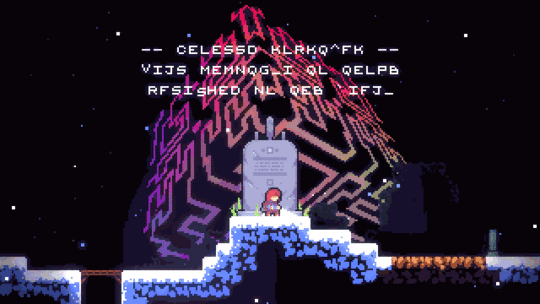
There isn’t a lot of information out on Celeste right now—aside from a grand look at the art style, which promises to be more detailed and rich than its predecessor, and the acknowledgement from Thorson that the game already has 90 levels. There’s large chunks of art littered across several Twitter accounts showcasing the 3D overworld, and a set of pixel trees underneath a star-lit sky. All hint at a game sure to interest those interested in climbing the mountain of difficulty that Thorson and Berry can bring to the table.
Interested parties can follow along on the Celeste devlog, as well as the official website where you can access the original PICO-8 prototype.
The post Next up for the creator of TowerFall, a game about climbing a mountain appeared first on Kill Screen.
Sinner’s Sorrow wants to unsettle you with its black-and-white world
If you asked me to describe bitHuffel’s second title, Sinner’s Sorrow, in one word after having seen the teaser trailer, it’d be bleak. It’s all skeleton soldiers, sentient trees, large demons, bashed iron shields; dark medieval conflict. It’s also a drastic departure from the studio’s first project, Zenizenzic (2015), but for developer Ruud Koorevaar that’s half the fun. “On this new project I want to be challenged by new ideas and new approaches,” said. “Going completely the opposite direction in regards to art style and gameplay is definitely one way to accomplish that.”
While it may be cliché to say,t here’s definitely a touch of Dark Souls (2011) about this new game. And I’m not pulling that out of my arse: Koorevaar cites the title as an inspiration, alongside other game series’ such as Uncharted, Darksiders, and Diablo. However, he warns players away from the idea that it might ape one of these inspirations. “We are forging our own approach,” says Koorevaar, “to what we want to do for gameplay and how we want to tell our story.”
“pulls you through not just a few unsettling and surprising situations”
Part of that approach ties in to the bleak tone of the game: “As a player you are put in a dark world,” continues Koorevaar. “You aren’t there without reason and the title of the game should hint towards what that reason could be, but I won’t go further into the story as that will be for you to discover on your own.”
The question arises, then, among all this namedropping and comparisons, and that’s what makes Sinner’s Sorrow unique? Two things. Firstly, there’s the art style, with all the 2D art being completely hand-drawn, with the flat sprites given depth using parallax and dynamic lighting. It’s also entirely drawn in black and white, although as you can see in the teaser trailer it looks crisp and just adds to the teaser’s atmosphere.
Second is the action. “It won’t be a murderously difficult experience,” says Koorevaar, “such as Dark Souls, unless you choose for it, but it will be a sweaty palms type of game which pulls you through not just a few unsettling and surprising situations.” You’ll be engaging in melee-driven combat, but also solving puzzles and exploring the game’s unusual world, too.
Bringing these two elements together, Sinner’s Sorrow is aiming to create a harrowing atmosphere you don’t see in many other 2D games. I think I’d like to revisit my opening sentence and amend my description of the game to two words: quite bleak.
You can find out more about Sinner’s Sorrow over on its website.
The post Sinner’s Sorrow wants to unsettle you with its black-and-white world appeared first on Kill Screen.
Kill Screen Magazine's Blog
- Kill Screen Magazine's profile
- 4 followers








